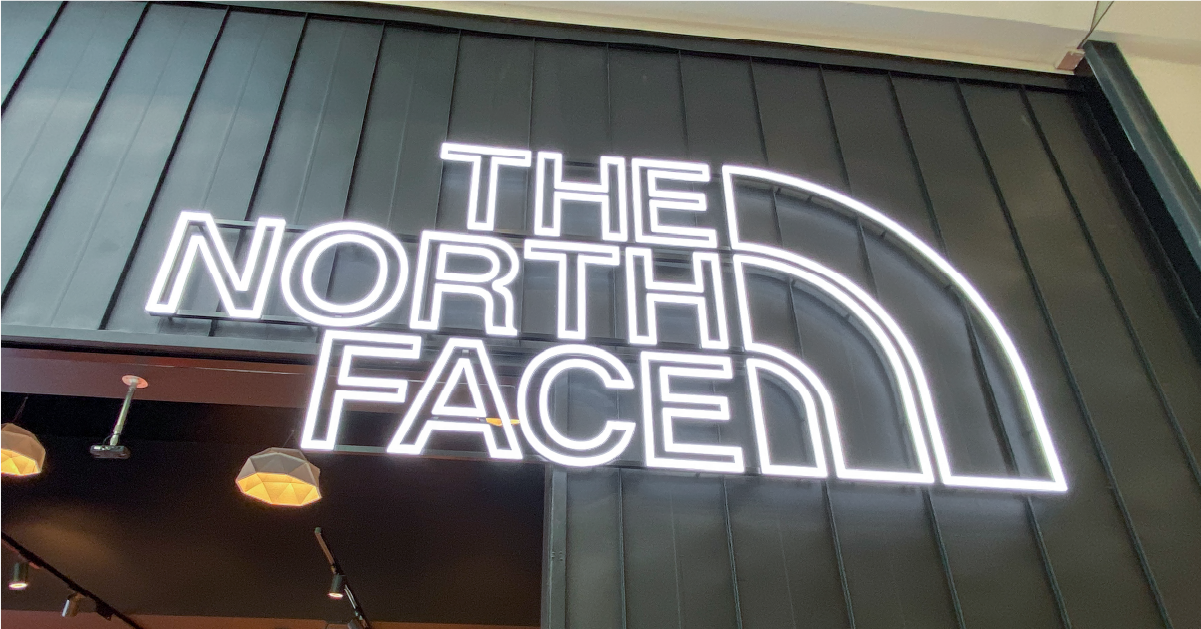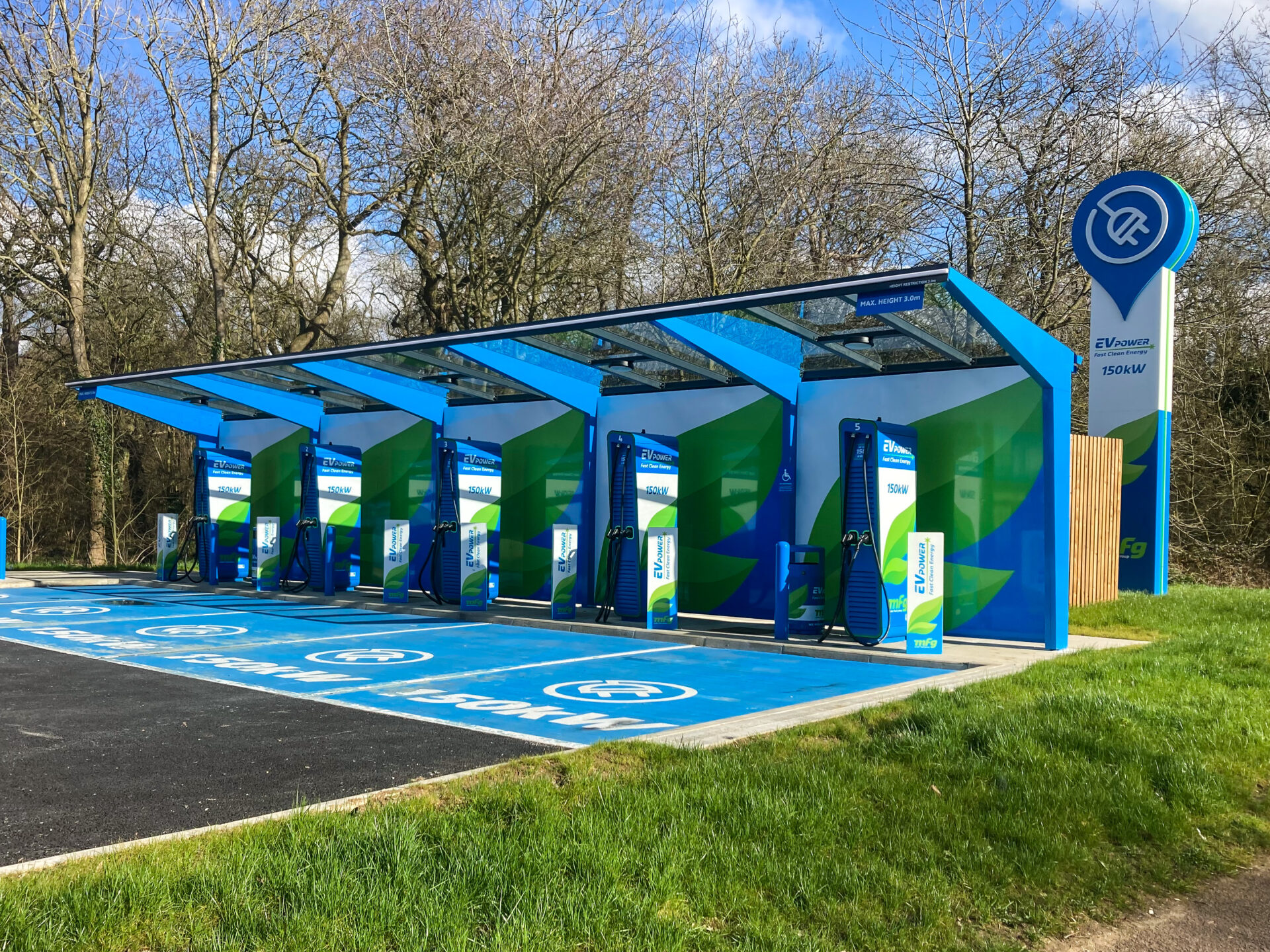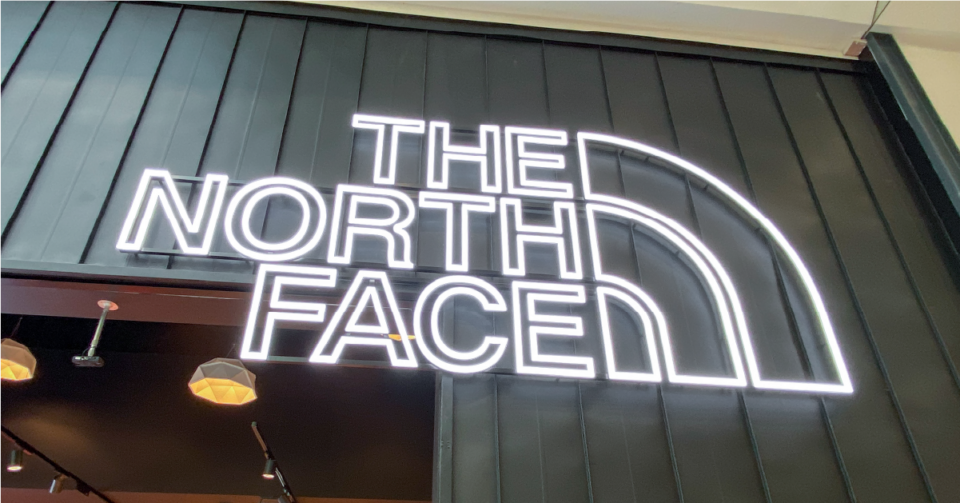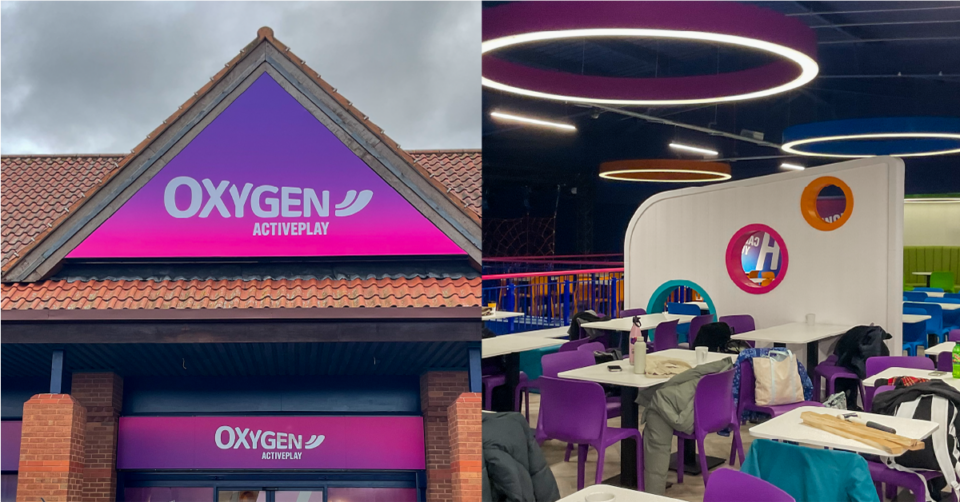Motor Fuel Group
MFG EV Signage – Standard Signage at Scale
Over the past decade, the emergence of electric vehicles (EVs) has been a transformative phenomenon in the automotive industry. The combination of technological advancements, environmental concerns, and shifting consumer preferences has propelled the rapid growth and acceptance of electric vehicles as a viable and sustainable alternative to traditional internal combustion engine (ICE) vehicles.
One of the key driving forces behind the surge in electric vehicles is the significant progress made in battery technology. Over the last ten years, there have been remarkable improvements in lithium-ion batteries, leading to increased energy density, longer driving ranges, and shorter charging times. This has alleviated the issue of “range anxiety” that many potential EV buyers had, making electric vehicles a more practical and convenient choice for everyday use.
Government policies and initiatives have played a crucial role in promoting the adoption of electric vehicles. Many countries around the world have implemented ambitious targets and incentives to accelerate the transition from fossil-fuelled vehicles to electric ones. Subsidies, tax credits, and rebates for EV purchases, along with the development of charging infrastructure, have helped lower the cost barrier and enhance the overall feasibility of owning an electric vehicle.

Automakers have also responded to the growing demand for electric vehicles by investing heavily in research and development. Several major car manufacturers have introduced fully electric models or hybrid versions of their popular vehicles, while some companies have even committed to phasing out internal combustion engines entirely in the coming years. This commitment to electrification has not only diversified the EV market but also sparked fierce competition, driving innovation, and pushing the boundaries of electric vehicle technology.
Powering the future of transportation in the UK
By 2030, the UK government has set an ambitious target to ban the sale of new petrol and diesel vehicles, effectively promoting the widespread adoption of electric vehicles. To support this transition, it is estimated that a significant expansion of the charging infrastructure will be required. The exact number of charging points needed by 2030 may vary depending on factors such as EV adoption rates, charging technology advancements, and government policies. However, various reports and estimates suggest that the UK will require hundreds of thousands of additional charging points to meet the growing demand.

In terms of the location of charging points, they should be strategically distributed across the country to ensure comprehensive coverage and accessibility for EV owners. Key locations for charging points include:
- Workplace and Commercial Areas: Providing charging facilities at workplaces, office complexes, retail centres, and other commercial areas can encourage EV adoption and enable EV owners to conveniently charge their vehicles while at work or during their shopping activities.
- Public Parking: Equipping public parking spaces, including car parks, park-and-ride facilities, and on-street parking, with charging points allows EV owners to charge their vehicles while running errands or engaging in leisure activities.
- Service Stations and Rest Areas: Installing charging infrastructure at service stations, motorway rest areas, and other high-traffic locations along major road networks is crucial to facilitate long-distance travel for electric vehicles.
- Public Transport Hubs: Introducing charging points at bus and train stations, airports, and other public transport hubs can encourage EV adoption among commuters and facilitate the use of electric vehicles in conjunction with other modes of transportation.
- Rural and Remote Areas: Ensuring charging infrastructure availability in rural and remote areas is important to promote electric vehicle adoption across the country, provide support to EV owners in those regions, and eliminate the barrier of limited charging opportunities.
Enter Motor Fuel Group…
Motor Fuel Group (MFG) is a prominent player in the UK’s fuel retail industry, operating a vast network of petrol stations across the country. With a diverse portfolio of fuel retail brands like BP, Shell, Texaco, and JET, MFG has established a strong presence in both urban and rural areas, serving a wide range of motorists.
Recognizing the rising prominence of electric vehicles (EVs) and the shifting landscape of transportation, MFG has expanded its operations into the electric vehicle charging sector. Understanding the need to adapt to evolving customer preferences and embrace sustainable solutions, the company has been proactive in retrofitting its existing petrol stations with electric vehicle charging infrastructure.

Through partnerships with renowned industry leaders in the EV charging sector, such as EVBox, ChargePoint, and InstaVolt, MFG is actively working to offer a reliable and extensive network of charging points across its forecourt network.
MFG’s commitment to the electric vehicle charging sector is evident in its ambitious expansion plans. The company aims to install thousands of charging points across its forecourt network in the coming years. By leveraging their existing locations, MFG can optimize their infrastructure to transform their petrol stations into convenient charging hubs, catering to the increasing number of electric vehicle owners in the UK.
With these expansion plans in the pipeline, there’s one element that is crucial to ensure each charging point station is effective, and that’s signage! The relationship between MFG and Blaze Signs began in 2021, as we worked alongside them to brand their typical sites across the country. This included the car washes, jet washes, vacuum and air services found at their sites.
As time went on however, we began working with them to bring their EV charging point projects to life. Motor Fuel Group needed a supplier that possessed the expertise and the capacity to fulfil a project as large as this, and we were chosen because of the key benefits that our business and our position in the industry can provide, namely the quality of service throughout the process from conception through to completion and additionally how we are set up in a way that allows us to look after all aspects of the project for the client, from surveys of the proposed site, scoping them, designing the signage and – of course – manufacturing and installing them.
Totems, Fast Charging & Service Stations
Service stations across the country are quickly being retrofitted and expanded to allow the ever-increasing numbers of electric vehicles to charge during their long journeys. We all know what a service station is, and you’re sure to have used one recently or have memories of picking up a drink and a bite to eat after filling up your conventional car with fuel.
The primary purpose of a service station is to provide a convenient stop for motorists during long journeys, offering essential services and amenities to ensure comfort, refreshment, and the smooth continuation of their travel. Service stations also provide parking areas for cars, motorcycles, and sometimes larger vehicles such as trucks or coaches, and it is these areas of service stations which are seeing the largest amount of change when it comes to EV charging.
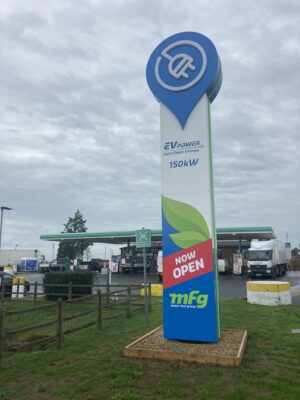
The MFG charging points are easily recognisable, with distinctive branding utilising the colours white, blue and green throughout the customer experience and touch points from the signage we create for the site to the paint colour used on the tarmac to signify that it’s a EV car parking space.
With these types of areas being large and often confusing to navigate, it’s imperative that the brand presence is significant, which is why we produce and install a large totem sign at a strategic location. A totem sign refers to a vertical sign structure commonly found at the entrance or in close proximity to commercial or retail establishments. It typically consists of a tall and slender pole or column that displays signage and branding elements to attract attention and provide information.
Totem signs are designed to be highly visible and eye-catching, often placed in prominent locations near roads or pedestrian walkways. They serve as a means of advertising, wayfinding, or identifying the presence of a particular business or facility; this is why they are the perfect type of sign to use for these EV charging points, in order to maximise the brand presence and value creation.
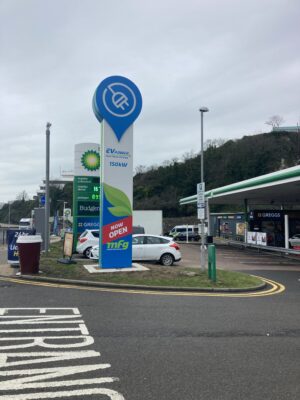
Due to the sheer scale of the project and the quantity of signs we’d need to create for the countless proposed chargers across the country, a standardised design and production was preferable, our 7 metre (23 feet) tall totem is made predominantly from aluminium which offers benefits such as durability, lightweight construction, corrosion resistance and versatility in design. The design of the totem was important to ensure it stands out from the various other totem signs advertising other businesses and most likely in the future other EV chargers, and to achieve this we broke away from the typical simple, rectangular design that are most common, integrating their “map marker” icon as a larger element at the very top of the totem.
This is also where LEDs for the internal illumination of the charging signifier lives. Illuminated signs provide enhanced visibility and attract attention day and night. They improve brand recognition, aid wayfinding, and increase safety. Illuminated signs are also extremely important in environments such as service stations because they mostly operate 24/7 and customers will be looking for the EV chargers during the night.
The “stem” of the totem sign also includes other useful information for the customer such as the brand message of MFG’s EV brand as well as the speed of the chargers displayed. With the MFG logo capping off the totem to add some final brand awareness, the design of the sign is complete.
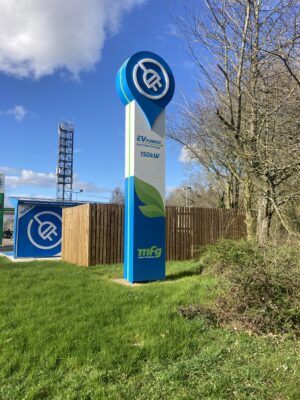
As mentioned before, this design is standardised and is implemented into as many sites as possible. Standardised production offers several benefits in manufacturing and other processes:
- Firstly, it improves efficiency by streamlining processes, reducing errors, and minimizing waste. Standardised components and processes lead to faster production cycles and increased productivity.
- Secondly, it ensures consistency and quality control. Standardised manufacturing methods help maintain uniformity in product specifications, reducing variations and ensuring a higher level of quality.
- Thirdly, it facilitates scalability and cost reduction. Standardised production allows for easier replication and expansion, making it easier to meet growing demands and achieve economies of scale for both Blaze and the customer.
- Finally, it simplifies training and enhances interoperability, as employees can become proficient in standardised processes, and products can work seamlessly together.
These totems are also quick to install on site, we are typically only on site for one day, which is incredibly important since we are working on trading sites. These areas don’t simply shut down for us to arrive and carry out our work, but instead we have to work around the public to ensure that their experience is not hindered in any way by our installation teams.
Bespoke signage & smaller sites… But still fast charging!
Service stations and dedicated areas for electric vehicle charging is only one piece of the puzzle, and in order to facilitate the UK’s driving population’s transition to electric vehicles, we’ll need chargers across our towns and cities, but there are a few challenges that we face.
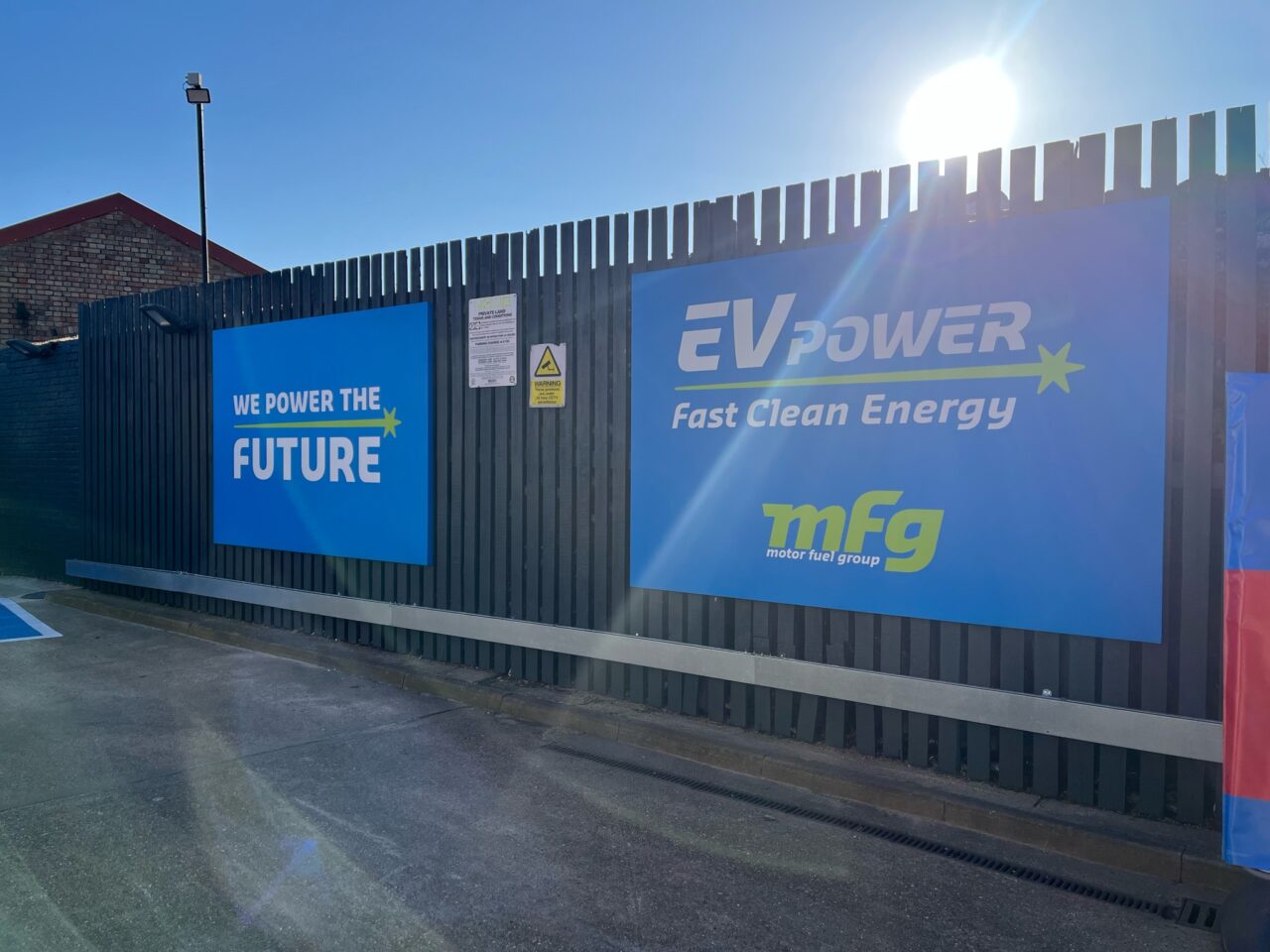
Finding suitable locations for chargers can be challenging. Space constraints in urban areas make it difficult to identify appropriate sites for charging stations, especially considering the need for accessibility, parking availability, and convenience for EV owners.
Motor Fuel Group are tackling these challenges by utilising the space they have available in their current estate, across their portfolio of fuel retail brands like BP, Shell, Texaco, and JET. These spaces allow MFG to implement a handful of charging points across the country, but it also means that brand space and opportunities are limited.
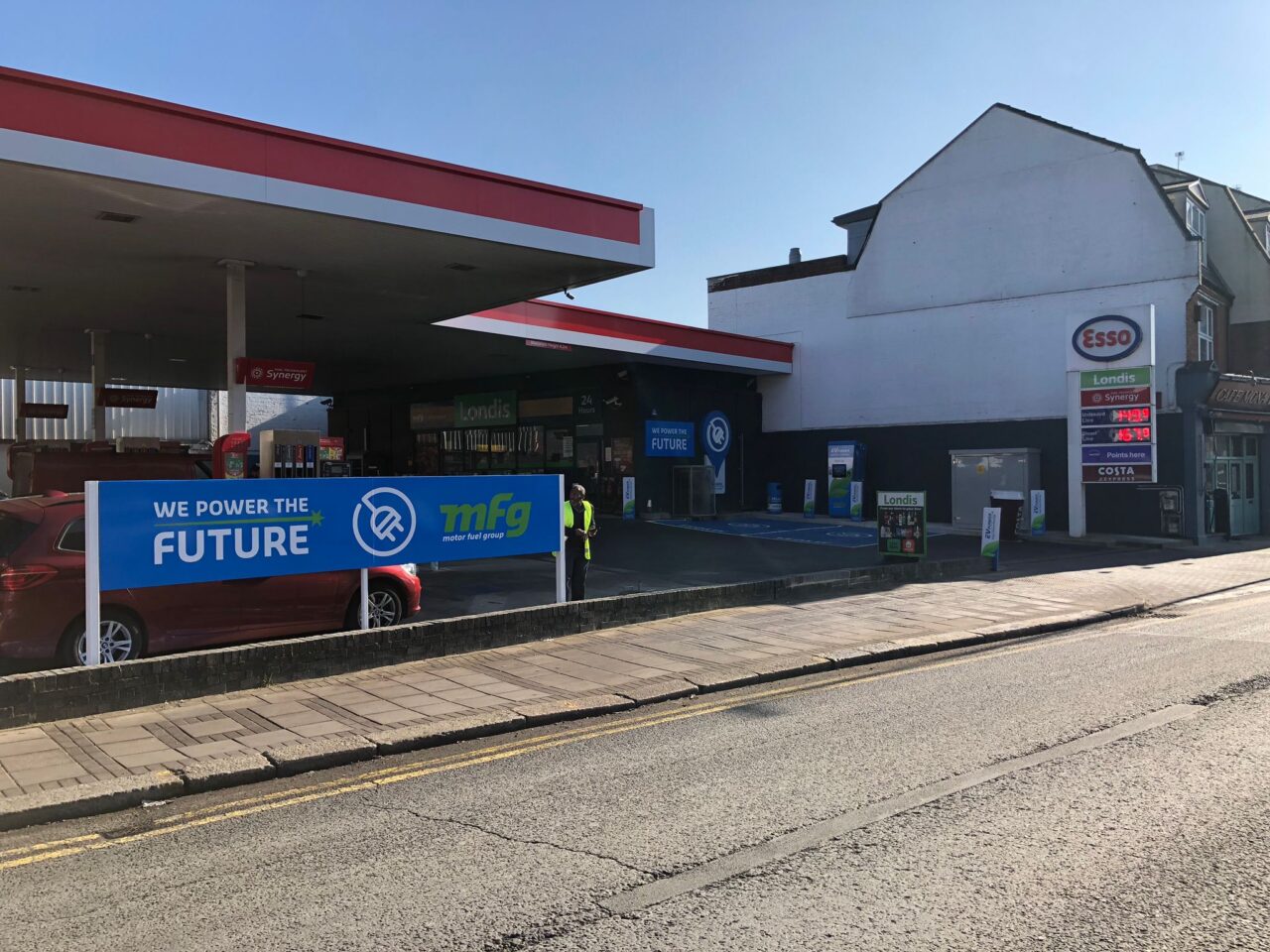
Totem signs, like the ones we are providing at the larger service stations are a great method of projecting your brand, but in towns and cities there are numerous challenges that can prevent these from being used:
- Urban areas often have limited open areas or sidewalks, making it challenging to find enough space for a tall and visible sign structure without obstructing pedestrian flow or impeding the view of other signs or buildings.
- Secondly, obtaining permits and approvals from local authorities can be a complex process. Urban environments are subject to stricter regulations and zoning requirements, and navigating the bureaucratic process to gain permission for installing totem signs can be time-consuming and may involve various stakeholders.
- Thirdly, underground utilities and infrastructure pose a challenge. In densely populated areas, there is a higher likelihood of encountering underground utilities such as gas lines, water pipes, electrical cables, or telecommunications infrastructure.
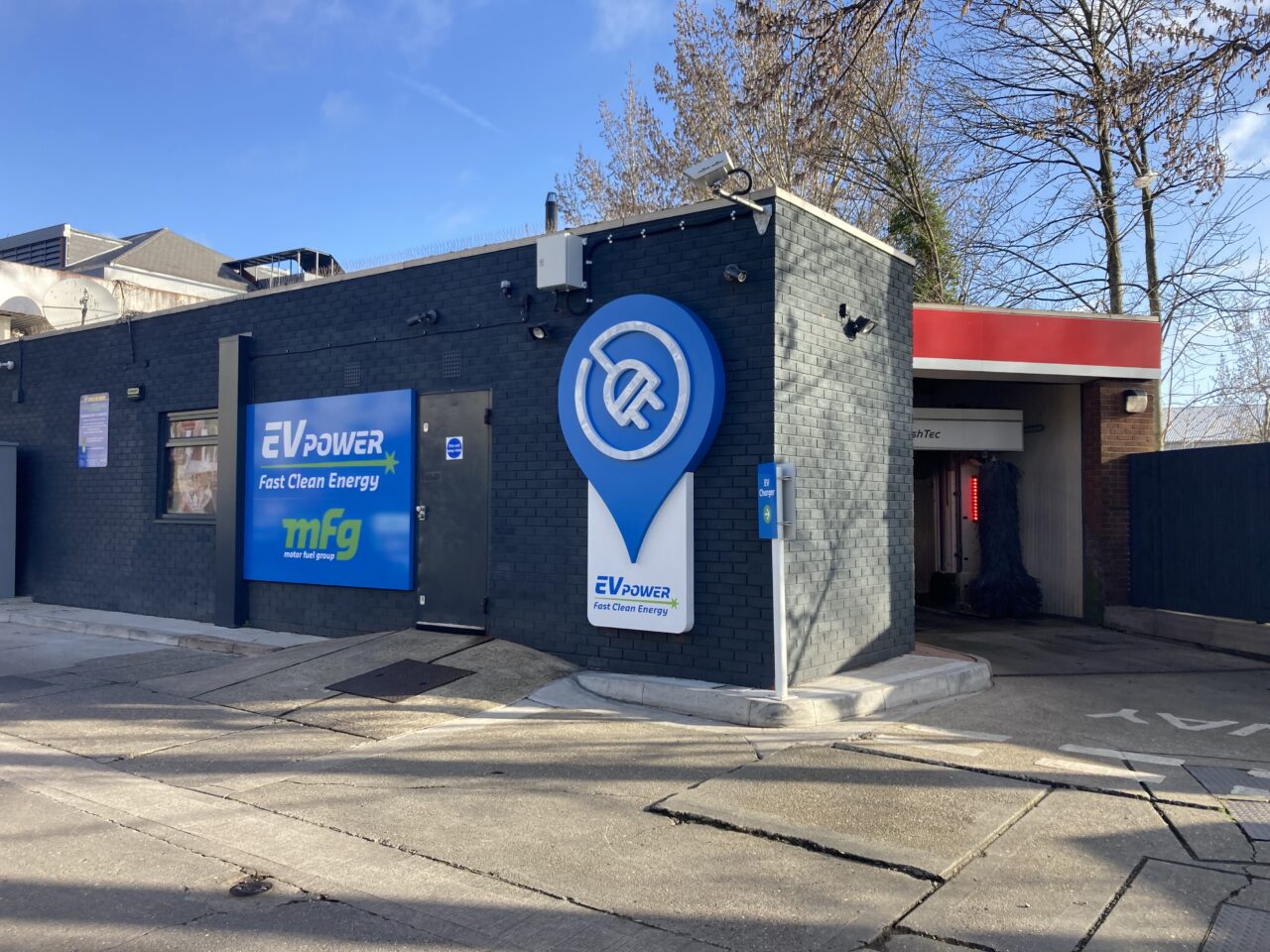
Instead, we utilise our in-house design and manufacturing expertise and capabilities to create different types of bespoke signage which can provide an incredible level of brand presence in these areas. Di-bond wall panelling, smaller 3 metre (10 foot) totems, and various freestanding signs can be found at these types of sites.
Over the course of 6 weeks, we worked to complete 25 of these sites, allowing us to properly flex our muscles when it comes to project planning and manufacturing facilities, especially when you consider the fact that we are still working around the public and minimising disruption to their day to day activities, an even greater challenge when you remember that we’re working in dense urban areas like busy towns and cities.
Even without the huge 7m totems however, these completed sites look like they belong to the MFG EV Signage family, and you’ll recognise them immediately if you are a regular customer of the brand. This effort is a testament to the versatility of our manufacturing facilities.
With the future of the BEV sector and accompanying electric vehicle charging industry looking bright, promising continued exponential growth over the course of the decade, we’re incredibly excited to see what is next. MFG are continuing to grow their EV charging offer for years to come, and we’ll be there to continue supplying them with our business signage solutions, no matter the location, scope or the challenges that might be thrown our way.
